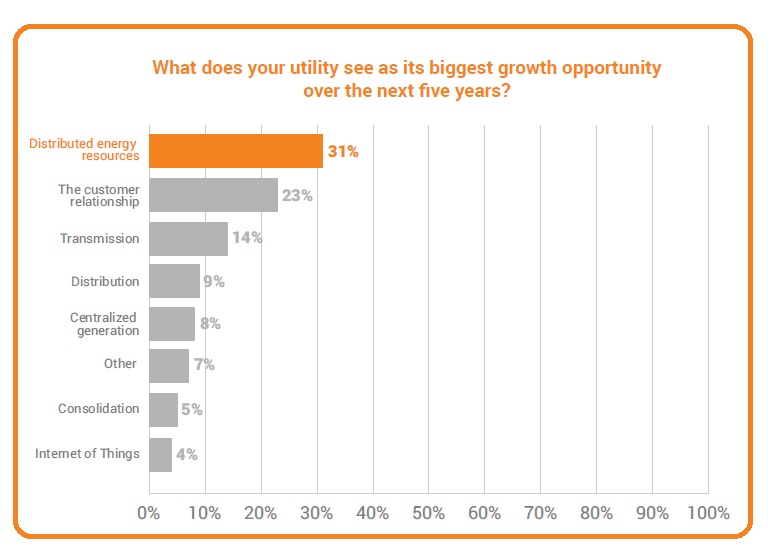This article comes from the executive summary of a report on the Utility of the Future, Pulse Survey of 2014.
Technology and policy changes in the utility sector create challenges and opportunities for grid operators and market players. To check the pulse of how key energy stakeholders are responding to these changes, DNV GL has conducted a survey of 200 industry executives. The results of this survey provide unique insights into the expectations of utilities, system operators, equipment suppliers, policy makers and other suppliers to the energy industry.
Overall findings from this pulse survey reveal that one of the most significant challenges facing respondents is the integration of distributed generation. Nearly 40% of respondents believe that this will be the most significant challenge facing the utility industry over the next five years. Subsequently, key policy issues on the minds of many are the impact of net metering and distributed generation interconnection, greenhouse gas (GHG) and emissions control and the evolution of the competitive retail markets. Together, over 78% of respondents believe these policy or regulatory advances will have the greatest impact on the industry’s evolution by 2020. Recently, the market has seen rapid growth in the area of distributed generation, particularly in the area of clean energy resources — the amount of distributed storage installations has doubled every two years with even higher growth rates for residential photovoltaic solar. In many regions, state and regional energy goals actively promote distributed generation. Such distributed technologies are creating a unique environment for our future grid, leading to fundamental changes in how and where electricity is generated and how it moves over our networks.
In the midst of significant changes in distributed generation and evolving policy around energy and the environment, the industry appears to be taking a proactive stance. On the whole, power providers plan to actively engage with new entrants in the areas of distributed generation and retail supply. In particular, 55% of public and private power providers plan to take an offensive position relative to new stakeholders entering the distributed generation space and 52% of private power providers plan to do so in the retail space. Furthermore, more than four of five see technology adoption or engagement in policy and regulation as actionable means for addressing industry changes. Demand response and support for distributed generation appear to be strong pursuits for entities engaging in behind-the-meter offerings.
Overall, the industry is ripe for change and is generally eager to adapt. Opportunities remain to shape the industry’s future and many see the potential to build avenues for growth. As such, it is important for industry players to position themselves to capture new opportunities to prosper as the grid evolves. Now is the time to develop strategies for adapting to and influencing the changes to come.
The utility sector has seen significant transformation in the past decade, prompted in part by the development and deployment of advanced technologies and the evolution of industry policies and regulations. In recent years, such changes have resulted in notable shifts in the marketplace, including new offerings and market entrants, as well as the formation of disruptive business models. Evolving customer offerings around photovoltaic solar, energy efficiency and demand response at the wholesale and retail levels and recent engagements by Google, Comcast and GM in the power sector are but a few examples of how the industry is changing.
To measure the industry’s pulse and capture the challenges and opportunities on the minds of leading industry executives and managers today, DNV GL surveyed 200 energy professionals across the U.S.. This document summarizes survey findings and provides key insights about these results and the forces shaping the utility of the future.
To view the full report, fill out this form:
http://www.dnvgl.com/energy/download/U-of-F-Pulse-Survey-2014.aspx
Filed Under: News, Policy





